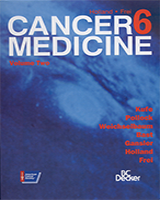By agreement with the publisher, this book is accessible by the search feature, but cannot be browsed.
NCBI Bookshelf. A service of the National Library of Medicine, National Institutes of Health.
Kufe DW, Pollock RE, Weichselbaum RR, et al., editors. Holland-Frei Cancer Medicine. 6th edition. Hamilton (ON): BC Decker; 2003.

Holland-Frei Cancer Medicine. 6th edition.
Show detailsTyphlitis refers to a clinical syndrome of fever and right lower quadrant tenderness in a neutropenic patient after cytotoxic chemotherapy. Typhlitis (from the Greek word typhlon, meaning cecum) is also referred to as neutropenic colitis,64,65 necrotizing colitis,66 ileocecal syndrome, or cecitis.67 This syndrome is seen in patients treated with cytotoxic drugs usually for hematologic malignancies, especially acute myelogenous leukemia and acute lymphoblastic leukemia.68 Typhlitis appears to be more common among children than among adults.67,69–72 Typhlitis may also complicate the treatment of patients with solid tumors73 and granulocytopenia from other causes,74,75 Although the cecum is most commonly affected, other potential areas of involvement include the ileum and ascending colon.66,67,72,76 In our experience, patients with typhlitis have been granulocytopenic for 1 or more weeks before the onset of symptoms. Typhlitis is a consequence of overgrowth of clostridia, particularly Clostridium septicum, in granulocytopenic patients.77 The process appears to begin with mucosal disruption, leading to secondary intramural infection and subsequent edema, induration, and wall thickening.66,76,78 Chemotherapeutic agents may themselves alter mucosal integrity.79 To date, a predictor of this syndrome has not been identified, in that chemotherapy, neutropenia, fever, and antibiotic use are found with equal frequency in patients with and without typhlitis.66,76,80
Clinical Presentation and Diagnosis
Typhlitis should be suspected when a neutropenic patient presents with fever and abdominal pain, particularly in the right lower quadrant, with or without rebound tenderness. Associated diarrhea, often bloody, is common. Abdominal distention and nausea and vomiting are also common symptoms.66,71,76 Given that the clinical presentation can be subtle and there are no pathognomonic clinical findings, one must consider other entities in the differential diagnosis, such as pseudomembranous colitis, colonic pseudoobstruction, acute appendicitis, ischemic colitis, inflammatory bowel disease, and infectious colitis. Imaging studies can be useful in supporting a diagnosis of typhlitis. Computed tomography (CT) and ultrasonography can demonstrate bowel wall thickening and exclude other intraabdominal processes. CT and magnetic resonance imaging (MRI) are more sensitive for diagnosis than are other imaging modalities, and they are noninvasive.78,81 Plain radiography is nonspecific, but may show any of these features: a relative paucity of bowel gas in the right lower quadrant, with a slight distention of surrounding small bowel; a soft-tissue density secondary to an atonic, fluid-filled right colon that may be dilated and may exhibit thumbprinting of the mucosa; or small bowel obstruction.72,82 Findings at colonoscopy include mucosal erythema, edema, friability, and ulcerations. In some cases, a nodular tumorlike mass is seen.83 Colonoscopy should be done cautiously to minimize the risk of perforation. Alternatively, flexible sigmoidoscopy can be performed to exclude pseudomembranous colitis, inflammatory bowel disease, and infectious colitis. Barium enema, if it is to be performed, should also be done with caution, and findings include cecal distortion with edema and effacement of the mucosa, rigidity, loss of haustral markings, and thumbprinting.67,71 On pathologic examination, the bowel is dilated and edematous, and the mucosa is frequently hemorrhagic and may contain multiple ulcerations.76 Transmural involvement may be present, and there is usually a sparse inflammatory infiltrate, edema (so-called phlegmonous colitis), intramural hemorrhage, necrosis, and evidence of either bacterial or fungal infection. Leukemic infiltration is not routinely found.80
Management
Patients with typhlitis are often very ill and have an increased mortality rate.71 The treatment is conservative medical management while awaiting recovery of granulocytes. At diagnosis, patients should receive broad-spectrum antibiotics with anaerobic coverage.71,73 In some cases, patients were found to have positive blood cultures for aerobic gram-negative bacilli. Marrow-stimulating growth factors may be considered. There are anecdotal reports of successful treatment with oral vancomycin; antiperistaltic agents should be avoided.80 Recurrence is rare, and most patients recover uneventfully. Surgical therapy has been successful in rare patients who fail medical treatment.65,68,71,73 Proposed criteria for surgical intervention include (1) persistent gastrointestinal bleeding after resolution of neutropenia and thrombocytopenia and correction of clotting abnormalities; (2) evidence of free intraperitoneal perforation; (3) clinical deterioration requiring support with vasopressors or large volumes of fluid, suggesting uncontrolled sepsis; and (4) development of symptoms of an intraabdominal process, which, in the absence of neutropenia, would normally require surgery.65,71 A review of the published literature (Table 155-3) suggests that surgical versus medical management is associated with better outcomes. However, these results must be cautiously interpreted, as the two patient groups are not comparable. It is likely that medically untreated patients had greater severity of illness and may have been unfit for surgery.65
Table 155-3
Management and Outcome of Typhlitis.
- Typhlitis - Holland-Frei Cancer MedicineTyphlitis - Holland-Frei Cancer Medicine
Your browsing activity is empty.
Activity recording is turned off.
See more...